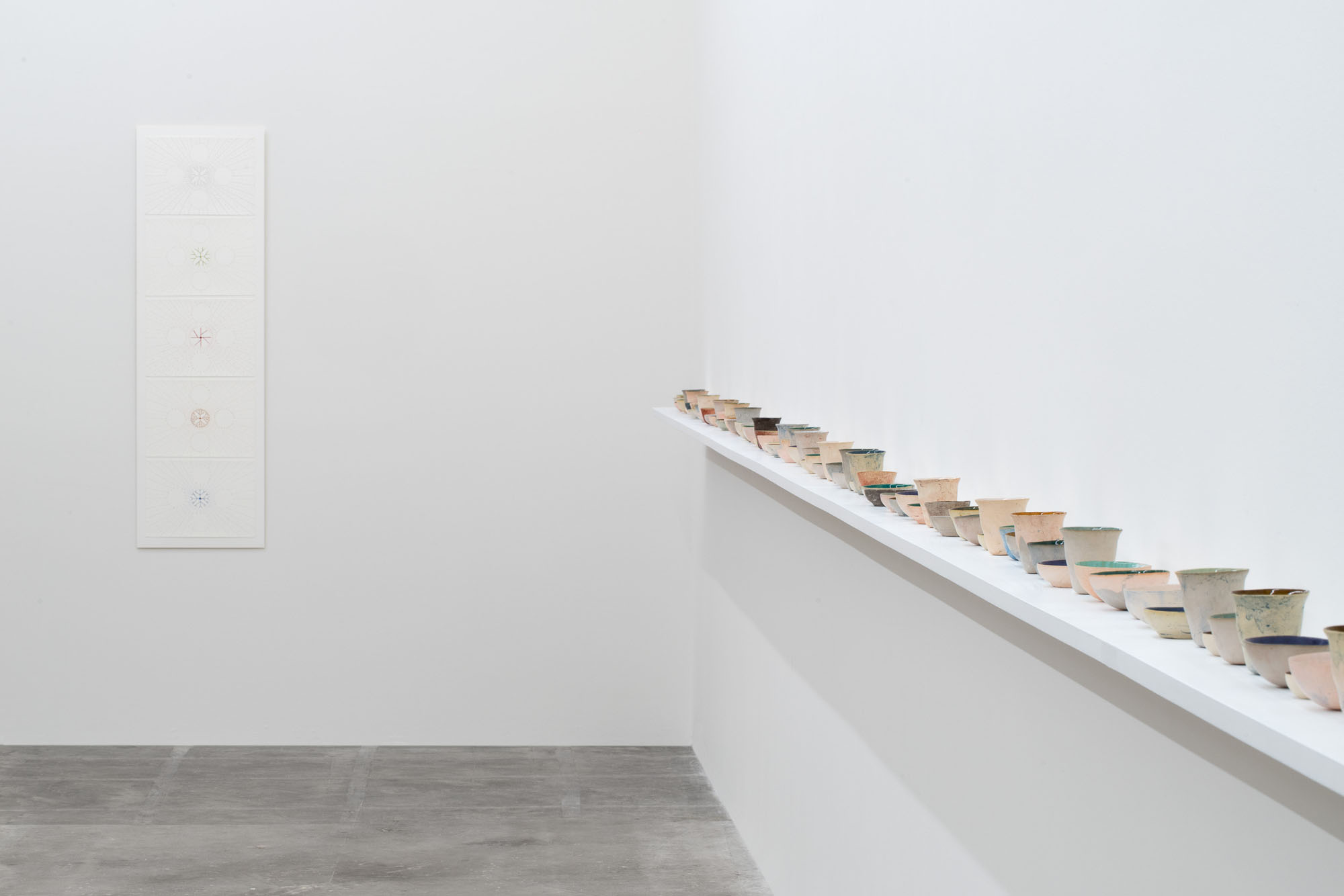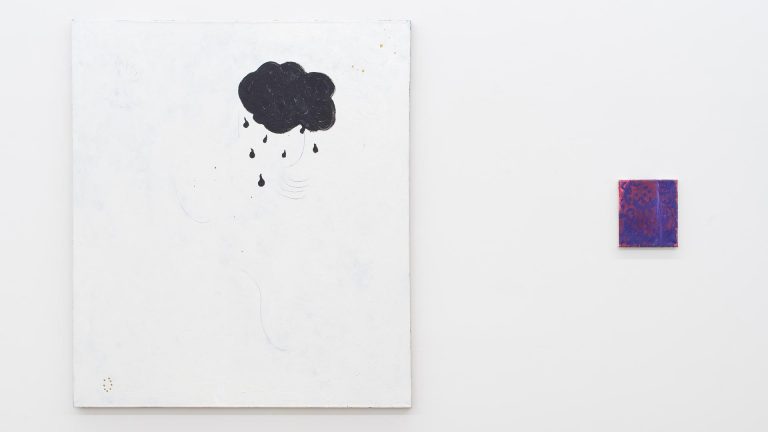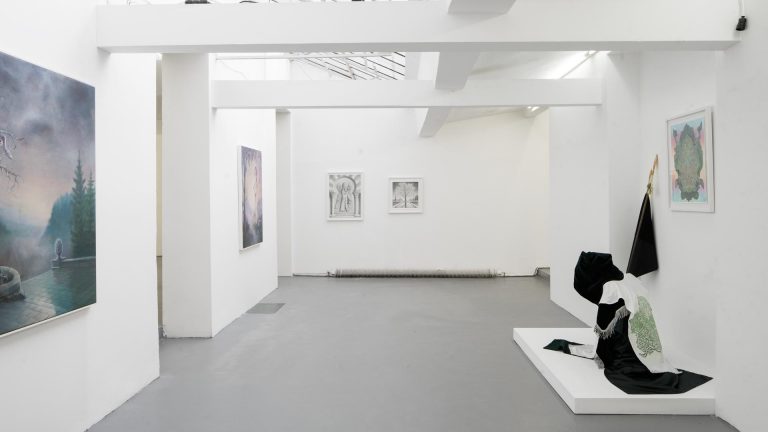Artist: Habima Fuchs
Exhibition title: The Great Ocean Continuously Creating
Venue: SVIT, Prague, The Czech Republic
Date: November 13, 2019 – January 18, 2020
Photography: Tomas Soucek / all images copyright and courtesy of the artist and SVIT, Prague
Nature can be graceful, beautiful, or violently sublime, yet it seems that only at the cost of self–denial does she allow herself to be gentle and delicate. When her creatures and creations pride themselves on a fragile elegance that reconciles evanescence with patience or mourning with peace, they all seem to pay the price of vulnerability, transience, or death. As a matter of fact, we are talking mainly about an offspring that is less alive than lifeless. About the skeletons of fading foliage. About the minute structures of the coral reefs. About the textures of spider webs, about the curves of abandoned seashells, or the spirals of the sacrificed inflorescences. As if the cosmos itself listened to the gospel and “hid these things from the wise and learned and revealed them to the little ones” (Matthew 11:25).
Nevertheless, one of these tiny things stands out above the others and it is only typical that its unobtrusive appearance caught the eye of a stargazer. Just when Johannes Kepler was about to give up on the task of presenting his friend with a gift that would be as remarkable as infinitesimal, suddenly, “by a happy occurrence, some of the vapor in the air was gathered into snow by the force of the cold, and a few scattered flakes fell on my coat, all six–cornered, with tufted radii. […] Here was something smaller than a drop yet endowed with a shape. Here, indeed, was a most desirable New Yearʼs gift for the lover of Nothing, and one worthy as well of a mathematician (who has Nothing and receives Nothing) since it descends from the sky and bears a likeness to the stars (On the Six–Cornered Snowflake, 1611).” It wouldn’t be long before Kepler saw the entire universe in the flakeʼs geometric structure, but the flake resembles the stars for one more reason. Just like the stars, it represents primarily an optical phenomenon; try to touch it, and it will melt back into water as if returning to the primordial cosmic state of the “deep waters” (Genesis 1:2).
You will probably object that while a flake cannot stand even a little bit of the sun, the stars are both fixed and furious. Yet still, does not their light, in spite of all its magnificence, have something similarly fine, gentle, and delicate about it? Besides, the starry sky can be very well reminiscent of the “terraces” or “fireworks” of light, yet it seems that we are particularly attracted to the stars that find themselves at the very edge of a telescopic illusion. We do not have to go far from our flake–covered stargazer to prove a point: Giordano Brunoʼs boundless mind could have been dazzled by myriads of cosmic suns, but ultimately it aimed for the “immensely distant stars”, twinkling as the Neoplatonic will–oʼ–the–wisps from behind the dark frontiers (The Ash Wednesday Supper, 1584). Galileo Galilei did not pursue the high officials of the heavens as much as he looked for “a crowd of others that escape natural sight that it is hardly believable” (Star Messenger, 1610). This obsession would permeate the later observation diaries of William Herschel as well. These and similar works are interspersed with an inconspicuous yet constant emphasis on a barely–perceptible glow of the stars that emerges from the black “regions of utter
desolation” as indexes of the astronomical unknown. In other words, if the stars are to live up to their name, they must be both visible and always about to disappear in the distance.
Is it not a bit suspicious how starlight permanently escapes the hands of artists? We do know many images of the starry heavens indeed; however, only a few painters have managed or at least tried, to capture the starry sky as we actually see it. Let us put aside the dispute over what it actually means to see (e.g. to see naturalistically etc.). The fact remains that even the slightest touch of colour is too impregnated with the bodily experience of an opaque imprint and solidifies the starlight – the distant light escaping the Cartesian fingertips Diderot spoke about – into a heavy stain. It is only typical that mimetic efforts to represent the stars reached one of their peaks when portraying sunspots.
The subtlety of stars is revealed by yet another contrast, both trivial and significant. If we were to look for an imaginary negative of the stars above our heads, would we not find one in a meteor(ite), a “falling star” after all, whose cosmic character continued to be denied until the late 18th century? This may be for a good reason. Not only does a fiery flash turn into an ordinary– looking stone literally overnight, betraying all its distant relatives, but also the meteor(ite) dares to infest the cosmic purity with an association to geological violence, with the vulgarity of igneous rocks, or the abominations of earthly debris and dirt. Let the stars be the second suns with thousands of their own planets, echoed through the astronomical Europe; but let the starlight travel through a crystal–clear mathematical space that is not polluted by undisciplined trash.
What does this all have to do with the Habima Fuchs’ exhibition? If we were to highlight just one of the qualities that her works share, it would be precisely the subtlety and delicacy mentioned above. After all, if we accept an old thesis that art perfects or even enthrones nature, we can just as well say that it can literally undo the suffering behind her
often–merciless beauty or violent grandeur. Ink and clay are her blood and a “body, which is broken for us”. A delicate drawing has the power to redeem the thermonuclear ferocity of the stars, its delicate rays can incarnate the patience and delicacy of their shine. This time, a pen can weave the subtle spiderwebs without any victims, the leaves do not have to rot to reveal their latent drawings, and the sensitive hands of a sculptor can mould geological formations without the devastation of earthquakes. This time, fragile objects are not followed by their inevitable destruction. Thus, the exhibition “The Great Ocean Continuously Creating”, which in fact begins on the full moon, is a display of fragility: giving nature yet another chance to be tender and to turn the burning sunshine into peaceful lunar light.
Prague, 10 November 2019
Ondřej Váša






































